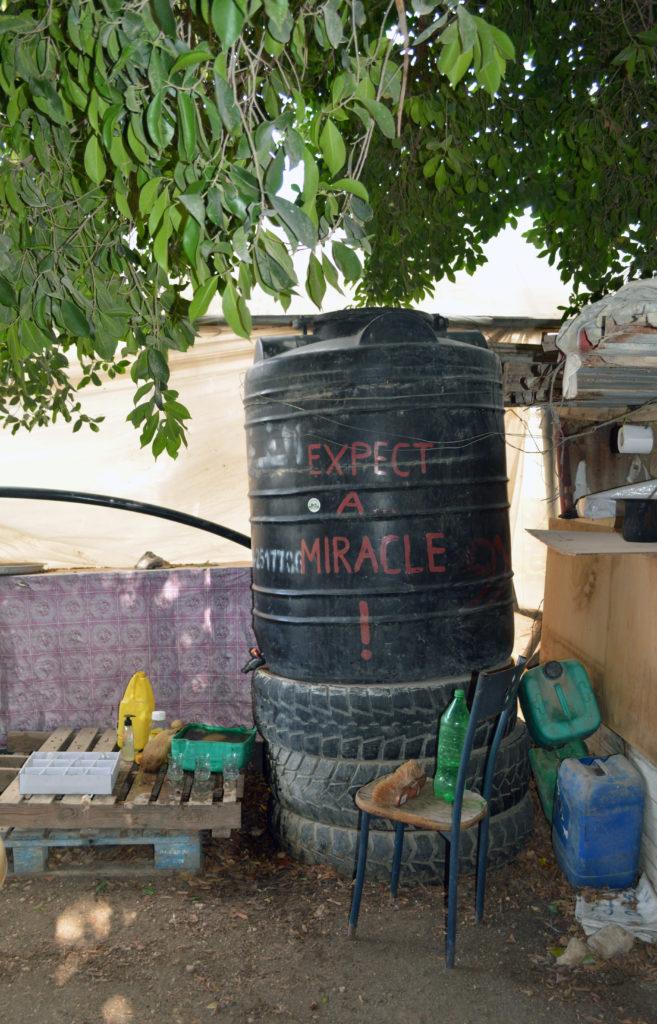Can words (re)make worlds?
In “If words (re)make worlds” Atreyee Gupta asks fundamental questions about language and the power of words in shaping one’s understandings and worldviews. The article was published in 28 Magazine the twelfth edition titled “Knitting”, funded by the A.M. Qattan Foundation, conceptualized and curated by writer and cultural researcher Adania Shibli. Knitting was the first edition of Creative Net, which is a project of the Public Program at A. M. Qattan Foundation. Creative Net is a biennial programme that facilitates a visit for a group of thinkers and creators from all over the world to gather in Palestine and engage with their Palestinian peers.

Garden in a Palestinian residence, Atreyee Gupta, Al-Khalil 2017
“Expecting Miracles” a container for recycling waste at Hakkortna farm, Atreyee Gupta, Tulkarm 2017
In Tractatus, the German philosopher Ludwig Wittgenstein had written that “the limits of my language mean the limits of my world.”[1] Wittgenstein’s argument was that concepts and ideas that cannot be synopsized in language demarcate the limits of thought, and therefore the limits of particular worldviews. I remembered Wittgenstein as I traveled through Palestine in the company of friends whose generous translations gave me a glimpse of a world that I could not fully understand but nonetheless sensed a familiarity that I could not verbalize. There was much that was familiar. Most of all, everyday forms of resistances – foot dragging, concealment, false compliance, stubborn persistence, and so on – seemed remarkably familiar as weapons of struggle wielded by relatively defenseless groups. But the terms in which I recognized such acts of protracted resistance are grounded in India, a former colony whose languages of resistance in the past and in the present no doubt shape the parameters through which my own thought and my understanding of the world unfolds. Yet, I also recognized that Palestine is not India. Each has its own particularities. Forms of resistance envisaged as practices on the ground are thus necessarily particularized and emphatically embedded within the specificities of particular lived contexts. Indeed, everyday practices of resistance can hardly be generalized across conditions of domination, for forms of domination differ across sites of oppression. By extension, tactics of resistances at work in India, or elsewhere, may not only seem entirely inappropriate in Palestine, but also the strategies of resistance that look similar at face value may be revealed as fundamentally different upon introspection. Despite this, I could not shake a sense of familiarity. In what language, then, do intimate strangers speak, I wondered.
Familiarity withstanding, there is something to be said for underscoring particularity. We all know what it means to be instrumentalized for the gains of others. We have all seen how the neoliberal economy preys upon the disenfranchised. Against this global, the local calls out for identification, for the naming of the particular, for recollecting and asserting the place from which we speak in different languages, speak of different histories, along with the discrepancies internal to our place in the world. In what language, then, do intimate strangers convey an unshakable affinity that is felt intuitively?
If words indeed mark the limits of worlds, can they also bridge worlds by way of opening up the possibility of improvisational collaborations and bonds of solidarities that simultaneously acknowledge both familiarity and difference? What kinds of lexicons would such a “bridging” entail? Can an experiment in lexicon-making translate embodied action across life worlds into something like a hybrid language of communication? There is power in hybridity, for it is constitutively subversive and transgressive. Hybridity “intervenes in the exercise of authority not merely to indicate the impossibility of its identity but to represent the unpredictability of its presence,” to use Homi Bhabha’s words.[2] Then, is it a hybrid lexicon that most fully responds to intuitive affinities? Hybrid words, after all, are strategic devices, devices whose work is to knit solidarity around affective senses of familiarity without catapulting into an undifferentiated togetherness and without effacing difference.
Think, for instance, of the Arabic word sumud, a noun meaning steadfastness or staying put, a noun that was transformed into a verb after 1967 through the dialectic of oppression and the practice of resistance. From the perspective of someone resistant to anthropologizing, I accessed the practice of sumud only conceptually. But from the perspective of an intimate stranger, I immediately understood sumud as silent, persistent, resolute, and defiant. I comprehended it as a quality, a character, a garden that grows in defiance of all odds. [Image: Garden in a Palestinian residence in Al-Khalil] Replete with potential, I imagined sumud as agile, creative, and generative, thus reclaiming debris and destruction. I grasped that sumud re-assimilates waste back into the world as value at the Hakoritna Farm in Tulkarm. [Image: “Expect miracles,” Hakoritna Farm, Tulkarm]. This intuitive understanding came easily. For I found sumud to be kindred to jugaar in its creative potency. In Hindi, jugaar is a noun. But it is also a form of hijacking of the familiar. It refers to specific practical solutions developed by communities overlooked or underserved by the state in India. At its most basic, jugaar entails creative repurposing of industrial and urban waste. Although strictly a verb, jugaar nonetheless signifies an attitude of resilience and an agile willingness to make things work despite all odds. More than anything, it is a form of informal economy that continually operates at the level of the subterrain to disrupt the smooth flow of globalization.
Jugaar, however, is purely strategic, and therefore only a verb. Unlike sumud, jugaar operates fundamentally at the level of material. I could imagine jugaar living inside sumud and therefore becoming more than itself. But strictly speaking, as a language of active refusal that performs the repeated unmaking and remaking of the self to produce a condition of de-subjectivization, sumud exceeds the limits of jugaar. Nonetheless, both jugaar and sumud constitutively exceed Pierre Bourdieu’s notion of habitus, which continues to shape contemporary debates on action within life worlds. For Bourdieu, habitus is a cluster of inherited knowledge intuitively inscribed within the active body.[3] Yet, the constant agility that both jugaar and sumud entail, albeit under dissonant conditions of struggle, necessarily mean that the kind of accretion that Bourdieu takes for granted is impossible to accumulate. Instead, life worlds in flux function through an obdurate capillarity.
None of this, however, makes something like jugaar – a practice of resistance practiced by disfranchised communities in South Asia – analogous to anything like sumud. Nonetheless, it is via recourse to the word jugaar that I found myself addressing an affinity, a sense of familiarity, that I felt only intuitively but for which I had no vocabulary for description. Speechlessness is a disorienting affliction.
Might neologisms be a viable option for speech in the absence of a readymade vocabulary? Something like a combination of the Marxist sociologist Henri Lefebvre’s polyrhythmia and the visual anthropologist Christopher Pinney’s corpothetics? To put it simply, polyrhythmia, a word Lefebvre draws from musicology, refers to the unity of rhythms.[4] Its opposite is eurhythmy or disunity and arrhythmia or the fracture of rhythm. For Lefebvre, interactions among dissonant communities within the matrix of everyday spaces is analogous to a form of polyrhythmia. For the sociologist, whose work conjoined complex conceptions of place, space, and marginality, polyrhythmia then becomes not just a part of everyday social life but also an embodied experience of simultaneity of community. But even for Lefebvre, upon analysis, the seeming polyrhythmia of social life is replete with risk. At any given moment, polyrhythmia may give way to eurhythmy or, even worse, arrhythmia. The distinction between jugaar and sumud, in other words and in a different context, may complicate the work of strategic solidarity even between intimate strangers. In contrast, polyrhythmia offers a form of strategic essentialism that must continually confront its own limit to reinvent itself. Polyrhythmia is, after all, the synchronization of dissonant rhythms.
Devoid of ekphrasis and confronted with the limits of language, I turn to neologism. In contrast to polyrhythmia, a word that has an established currency within both musicology and sociology, corpothetics is a relatively flexible neologism coined by the visual anthropologist Christopher Pinney.[5] Observing the insurgent dual operation of corporeality and aesthetics in anti-colonial political images circulating in nineteenth- and early twentieth-century India, Pinney sought a term from the vocabularies of art history and anthropology to describe such an arrangement. None could be found, however. Born in Europe as post-Enlightenment disciplines engaged in knowledge production, both art history and anthropology were already implicated in the structures of colonialism. The relational bind between corporeality and aesthetics that Pinney observed in India, however, operated so far beyond the registers of post-Enlightenment rationality that the anti-colonial image slipped right through the nets of British surveillance precisely because the colonizers did not have the vocabulary with which to name, and thus recognize, the subversion.
If we combined polyrhythmia (a form of strategic essentialism) with corpothetics (a tactic of resistance that slips through the information networks that sustain power), if we twisted, coiled, curled, and bent words, might we arrive at a fuller dimension of interiority that can reconstruct the outside so radically that exteriority disappears in the process of communication? Will such words (re)make worlds ? Will the intimacy of strangers, then, find its own language in the future, its own insurgent vocabulary of affective solidarity and ultimate sovereignty beyond established structures of knowledge and power? Is that future already here, here in the presentness of ungovernable words that exceed their own worlds to verbalize a sense of familiarity that lies beyond the horizon of power?
[1] Ludwig Wittgenstein, Tractatus Logico-Philosophicus, trans. C. K. Ogden (London: Kegan Paul, Trench, Trubner & Co., 1922), 74.
[2] Homi Bhabha, The Location of Culture (Oxon: Routledge, 1994), 163.
[3] Pierre Bourdieu, The Logic of Practice, trans. Richard Nice (Stanford: Stanford University Press, 1980).
[4] Henri Lefebvre, Rhythmanalysis: Space, Time and Everyday Life, trans. Stuart Elden and Gerald Moore (London: Bloomsbury, 2004).
[5] Christopher Pinney, ‘Photos of the Gods’: The Printed Image and Political Struggle in India (London: Reaktion, 2004)